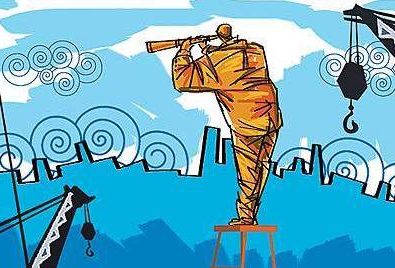The market economy at the present stage is presented in the form of a management system, the effective development and functioning of which depends on the state of its infrastructure and existing institutions. Today, there is a complication and expansion of the functions that these components perform. This, in turn, increases their importance in the general system of management. Let us further consider what constitutes the structure and infrastructure of the market. 
Theoretical aspect
For the first time, the term "infrastructure" was introduced into economic analysis to refer to the structures and facilities through which the normal activities of the army at the beginning of the 20th century were ensured. The word has Latin roots and comes from infra, which means below, and struktura - "location", "structure". Today there are different interpretations of this definition. According to some authors, the infrastructure acts as an entire service system. These researchers see the function of this institution in providing production and public services, in servicing them.
Other authors understand infrastructure only as providing for the reproduction process. They see its purpose in creating uniform production conditions and servicing them. There is another point of view. In accordance with it, the infrastructure represents the accumulated material wealth, acting as a combination of structures and facilities that provide the required material and technical conditions for the effective functioning of industrial enterprises. This institution is considered part of national wealth contributing to the creation of an unhindered field for activity.
By the 40s of the 20th century, there was an opinion according to which infrastructure was considered as a complex of industries that maintained the stable functioning of the material production process. In domestic economic publications, the development of market infrastructure began to be studied in the 70s. 
General information
The concept of market infrastructure includes a complex of economic and legal relations, connected in a single whole. In a significant way, the state of this particular institution contributes to the efficient reproduction of the turnover of products, the efficiency and stability of interactions relating to it. The structure and infrastructure of the market are different, but closely related to each other categories. With the development of economic relations, improvements in business methods, the requirements that apply to the system as a whole and its individual components in particular change. Infrastructure product market It is an indispensable link of a holistic economic system and subsystem. She acts as part of a political economy or economic life. The infrastructure of the modern market has a subordinate auxiliary character. It ensures the normal functioning of the political and economic systems.
Main tasks
The market and market infrastructure create conditions for the realization of the potential, which is inherent in relations relating to the turnover of products. In this regard, questions on the development of promising areas of improvement and analysis of existing institutions have significant theoretical and practical value. Special attention is being paid to the formation of the market infrastructure and the functioning of the state regulation system.This is due to international experience, according to which the maturity of this institution is a prerequisite for economic efficiency. Today, the commodity market infrastructure is in the process of constant reform. This process, in turn, requires a thorough analysis of all trends, determining the main features of the formation of the system. 
Product Exchange Specifics
The turnover of products takes place only if the individual components of the entire economic system fulfill the functions assigned to them in full, thus ensuring the stability of the reproduction process. In this regard functional structure necessarily involves the activity of three main segments: markets for services and goods, capital, labor. Each of them is distinguished, in turn, by the presence of specific links interacting with each other.
In particular, the services and goods market branches out into many sectors (food, clothing, tourism, and so on). The labor force segment breaks up into the sectors of skilled and unskilled workers, as well as plots for certain professions and specialties. The structure of the sphere of capital turnover includes the infrastructure of the securities and cash market. The whole system as a whole creates a complex of institutions, services, systems, organizations that carry out its maintenance and ensure stable functioning.
Process of creation
The market infrastructure, before becoming a relatively independent part of the sphere of social production, went through several stages, which are determined by major milestones in the process of social division of labor. The separation of crafts from agriculture, triggering the emergence of cities, objectively contributed to a significant increase in the exchange of products between large settlements and villages. This, in turn, led to the creation of infrastructure facilities. After some time, another division of labor occurred: trade separated from industry and agriculture. This contributed to a further increase in the exchange of products by attracting new territories to the economic turnover. These processes, in turn, required the expansion of infrastructure. 
Main links
Today, the general system distinguishes several major categories of paramount importance. These elements, in particular, include industrial (communications, transport, wholesale and so on), social (a set of objects involved in the service industries: social security, healthcare, education, communications, etc.) infrastructure. The latter's activity is aimed at satisfying individual needs, creating conditions for life and intellectual improvement of the population. As for the production infrastructure, it should be noted that it does not participate in the production of any products. It only creates the conditions for the normal functioning of this process. The market infrastructure is also relatively isolated in the system.
Important point
Elements of market infrastructure in the economy act only as a consequence of the peculiar functions that are assigned to this institution. Over time, they change and become more and more isolated from the tasks of the main production. In this regard, when defining the production infrastructure as a primary feature, support functions are used. The peculiarity of the economic activity of companies is that the result cannot be stored or backed up, because it is expressed in the form of a process of storage, movement, transfer of information and other things. Infrastructure cannot be described as a secondary area.
Market infrastructure
This institute is considered a new segment of the economic turnover of products.In the process of developing the economic system, there is a need to create a specialized field of activity to meet the needs of individual trading floors. The formation of the market, thus, led to the formation of new institutions, organizations that ensure its civilized functioning. 
Interpretation of the term
Market infrastructure is seen in a broad and narrow sense. In the latter case, the term is interpreted as a system of services, organizations and institutions. They serve the activities of structural market units. In a broad sense, the term is considered as a complex of material, technical, organizational and economic conditions. They, in turn, provide the area of circulation of products and the scope of transactions of sale.
In the latter case, the institute includes financial market infrastructure and a credit system. They are based on funds from the central and local budgets. In addition, the legislative framework is of particular importance in ensuring the functioning of the industry. It regulates interactions between business entities and determines the rules of product exchange. Thus, the market infrastructure is presented in the form of a set of legal rules governing the movement of services and goods, transactions, or a combination of enterprises, services, systems, institutions that provide services and perform the corresponding functions to maintain its normal mode of operation.
Institute Components
The main elements of the market infrastructure should include:
- Commercial banks and the credit system.
- Fairs, auctions and other types of over-the-counter organizational mediation.
- Emission system and banks.
- Exchanges (currency, stock, commodity and others), as well as their mediation, arranged organizationally.
- Tax inspection and tax system.
- Business communications and information technology.
- The system of regulation of employment of citizens, the centers of state and non-state assistance in employment.
- Special advertising agencies, media, information centers.
- The system of insurance of entrepreneurial economic risk and companies serving this area.
- Chambers of commerce, other voluntary public and state associations (associations).

- Customs system.
- Commercial exhibition complexes.
- Unions of employed workers.
- The system of secondary and higher economic education.
- Consulting (advisory) companies.
- State and community foundations whose activities are aimed at stimulating entrepreneurial activity.
- Audit firms.
- Special areas for free enterprise.
Institute Functions
Infrastructure should ensure a civilized approach of subjects to their economic activities. The components that make up the system cannot be considered external. They are formed directly in the course of market relations. The functioning of the institution in question is of a dual nature. On the one hand, it provides services to market entities, and on the other hand, the process of reproduction of labor resources - a person acting as a factor directly involved in the exchange of goods. The main functions of the system include:
- Facilitation of the implementation of interests of business entities.
- Increased efficiency and increased efficiency of participants based on specialization.
- Organizational design of interactions.
- Facilitation of economic and legal control, as well as public and state regulation of commercial activity.
Stages of formation
The formation of infrastructure, which began simultaneously with the reforms of a market economy, is a rather lengthy process.It consists of several stages. In Russia, there are three main stages:
- 1985-1992 This period is mainly associated with the emergence of components of market relations in the domestic economy. This stage can be regarded as the emergence of an institution. This is due to the fact that it was during this period of time that prerequisites were created for the formation of infrastructure as a subsystem of the economy. The emergence of a steady demand for the services of certain parts of the institute gave rise to their creation. Insurance companies, banks, currency and commodity exchanges, and investment systems began to develop especially actively during that period.
- 1992-1998 During this phase, the formation of the most essential components of the market infrastructure continued. The establishment of sustainable relationships between them also took place. At the same time, market infrastructure at this stage is characterized by unevenness. Institutions that provided intermediary services during the turnover of final consumption products reached a relatively high level. Financial organizations were also well developed.
- From 1999 to the present. At this stage, there is a qualitative improvement in infrastructure during the active functioning of the market. The main distinguishing feature of this stage is the trend towards the consolidation of similar institutions of the system. Along with this, some important links have not received the necessary distribution today. For example, the infrastructure of the securities market is currently rather weak. This, in turn, limits the ability of capital inflows to create and improve other important institutions of the system.

Consolidation processes take place in the product, insurance, and financial markets. The main development in the framework of product turnover they received in 2002-2005. The enlargement of trading enterprises is carried out by creating branched networks across the country.








